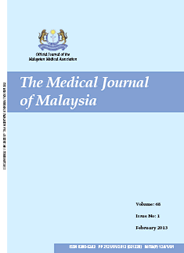MJM, Vol 70 Supplement 1 September 2015
Prevalence and predictors of ever water pipe smoking
among female school adolescents in Jeddah, Saudi Arabia
*Department of Community Health, Faculty of Medicine and Health Sciences, Universiti Putra Malaysia, Serdang, Selangor, **Department of Counselor Education & Counseling Psychology, Faculty of Educational Studies, Universiti Putra Malaysia, ***Department of Psychiatry, Faculty of Medicine and Health Sciences, Universiti Putra Malaysia
ABSTRACT
Introduction: Water pipe smoking (WPS) presents a challenge and threat to an international public health as it is not covered by tobacco control legislations in most countries. There are more than 100 million current water pipe smokers around the world. The objective of this study was to determine the prevalence and predictors of WPS among Saudi female school-going adolescents in Jeddah.
Methodology: A cross-sectional study using probability proportionate sampling was carried out in 40 female schools in Jeddah, Saudi Arabia between October 2012 and May 2013. Sample size (n= 5150) was calculated using the formula for hypothesis testing of two population proportions. A validated self-administered questionnaire was used to obtain student’s socio-demographic characteristics, beliefs and WPS behaviours. Data was analysed using SPSS version 22. Pearson’s chi-square test was used to determine the differences in the prevalence of WPS and socio-demographic variables. Multivariate logistic regression analysis was used for determining predictors of WPS behaviour
Results: The response rate was 98%. The mean age of the 5073 respondents was 15.5 (ranged, 12-19) years. The overall prevalence of ever and current WPS was 36.2% and 15.8% respectively. Ever water pipe users included ever exclusive water pipe or ever water pipe users who in addition used other forms of tobacco product. Among the 5073 respondents, 674 (13.3%) were exclusive WPS. The multivariate analysis showed that age, school type, mother’s educational level, student’s monthly allowance, family structure and perceived harmful of WPS were significant predictors of ever WPS behaviour. While age, mother’s educational level and perceived harmful of WPS were significant predictors of exclusive WPS behaviour.
Conclusion: Ever WPS is highly prevalent among Saudi female adolescents in Jeddah. The findings confirm the need for WPS prevention programmes targeting all adolescent female students in Jeddah with more focus on those attending private schools.
Keywords: Ever water pipe smoking, factors associated, female school adolescents
